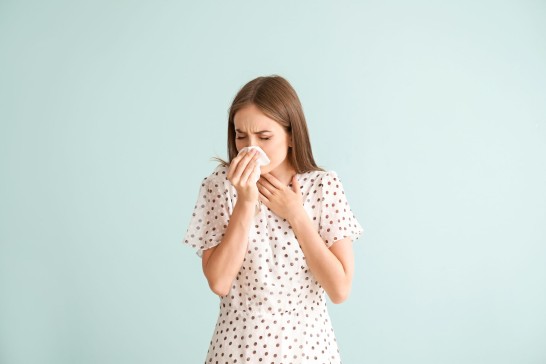Eosinophilic Esophagitis (EoE)
Eosinophilic esophagitis (EoE) is a recognized diagnosis that produces symptoms related to dysfunction of the esophagus. In EoE, large amounts of white blood cells, specifically eosinophils, collect in the inner lining of the esophagus resulting in inflammation. Typically, the esophagus is free from eosinophils and resulting inflammation, and so in EoE, a patient will begin to notice a difference in the way they can eat and swallow food. This condition can be difficult to diagnose as other conditions can present with eosinophils in the esophagus, and historically EoE has not been a common or well-known disease. Awareness has significantly improved however in the last decade, and patients are being recognized and diagnosed much earlier. This week, the FDA has approved the first ever treatment for EoE.
Symptoms of EoE
Many EoE patients also have symptoms of one or more allergic disorders like asthma, allergic rhinitis, atopic dermatitis (eczema) and food allergy. It is important for EoE patients to be properly assessed and tested for potential allergens as well as properly diagnosed for their atopic conditions. Similar to proper diagnosis, it is crucial that any and all allergic aspects of EoE can be properly treated in conjunction with management of the EoE. Patients benefit from a team of providers working together such as a primary care provider, allergy specialist, and gastroenterology specialist.
Early diagnosis of this chronic condition is important so patients can be educated and properly managed, sparing them from discomfort, malnutrition, and even life-threatening situations. An emergent situation can arise if inflammation becomes too great and causes narrowing in the esophagus, trapping swallowed food. In younger children, EoE typically presents with poor feeding, failure to grow properly, vomiting, reflux symptoms, and abdominal pain, whereas in adolescents and adults EoE most often presents with dysphagia (trouble or painful swallowing) and emergent esophageal food impactions.
Allergy Correlation
Airborne allergies can play a role, however adverse immune responses to food are the main cause of EoE in many patients. It can be more difficult to properly diagnose food allergies in EoE patients because many do not present with the typical symptoms associated with IgE mediated food allergy. Instead of immediate itching, flushing, hives and vomiting after ingestion of the offending food, the reactions can be delayed over hours or days. Milk, egg, soy and wheat are recognized as the most common triggers for EoE, however, conventional allergy tests often fail to detect sensitivity to the foods causing EoE. This is because most food allergy reactions in EoE are delayed and caused primarily by immune mechanisms other than classical IgE-mediated food allergy.
Diagnosis
Other than proper identification and diagnosis of atopic conditions, EoE must also be properly diagnosed itself as a disease. If EoE is suspected, a specialist performs an upper endoscopy, where a small tube with embedded camera is passed down the esophagus. The tube not only has a camera and light for inspection, but a small device to take samples, or biopsies of the esophagus. The biopsies of the esophagus are examined under a microscope for eosinophils and inflammation and are necessary to diagnose EoE. A provider looks for appropriate symptoms that were described above, visual inspection of the esophagus, and examination of tissue biopsies to make the final diagnosis of EoE.
Managing EoE
There are many viable options to managing EoE effectively. Food sensitivities or allergies can be managed by removing those offending foods from a person’s diet, but only under the direct guidance and supervision of a provider. A provider can advise eliminating a specific food, or a food group based on individual history, examination, and diagnosis. This elimination approach can be helpful to some, but it is important to only remove what is advised, and a medical provider will closely monitor a person and regularly discuss nutrition and intake. Many times, a dietician is added to the medical care team to make sure a person is still receiving all the necessary nutrients. A provider’s goal is to carefully add back any foods that can in fact be tolerated and are proven not to incite eosinophils in the esophagus.
Aside from adjustments to a person’s diet, there are some medications providers use to help provide symptom relief and management of the EoE. It is important to note that aside from the first medication being approved by the U.S. Food and Drug Administration (FDA) to treat EoE, typical options for treatment include proton pump inhibitors and steroids. Proton pump inhibitors (PPIs) reduce acid production in the stomach and have also been found to be able to reduce esophageal inflammation in some patients with EoE. PPIs are very commonly used as a frontline therapeutic for EoE patients. If PPIs do not work for a patient, another option may be swallowed topical corticosteroids. Swallowing small prescribed doses of corticosteroids so they come in direct contact with and treat the inner lining of the esophagus is the most common treatment.
Amanda Hofmann, MPAS, PA-C, is a graduate of Duquesne University, in Pittsburgh, PA. After spending 8 years in clinical practice, she joined United Allergy Services where she is currently the Vice President of Clinical. Amanda is also the past president of the Association of PAs in Allergy, Asthma, and Immunology.
United Allergy Services is also on Facebook, LinkedIn, or Twitter. See other interesting and related articles on the UAS Blog.
Allergies, Asthma, and Air Quality
As we move into the summer months, it is important to understand the connection between allergies, asthma, and air quality. While air pollution does not directly cause allergy or asthma, it can increase the risk of developing atopic disease. Air pollution can also trigger allergy or asthma symptoms or an asthma attack for persons with existing conditions. Air pollution usually increases during summer months. This pollution leads to an increase in related symptoms, urgent office visits, and emergency room visits.
Air Quality Components
Allergy and asthma symptoms can be triggered by two key air pollutants, ozone (found in smog) and particle pollution (found in haze, smoke, and dust).
- Ozone, a gas, is one of the most common air pollutants, contributes to smog, and is more common in cities where there are a lot of cars. In the summer months ozone can increase when intense sunlight and heat convert a mixture of tailpipe and power plant emissions with other chemicals resulting in unhealthy air. Allergy and asthma symptoms may trigger more easily because ozone is irritating to the lungs and can reduce lung function.
- Particle pollution is present and stable throughout the year but is typically worse near busy roads, during rush hour and around factories. It is also high when there is smoke in the air from wood stoves, fireplaces, or burning vegetation. These small particles can irritate the nose, throat, and especially the lungs, and also reduce lung function and cause asthma exacerbations.
Air Quality Reports
The United States Environmental Protection Agency (EPA) reports air pollution levels using the Air Quality Index (AQI). AQI reports the level of ozone and other air pollutants. When the AQI is 101 or higher, it is dangerous for people with allergies and especially asthma. Sometimes asthmatics can experience increased symptoms even when ozone levels are moderate (AQI 51-100). Many local news stations and weather forecasters report local air quality to advise the public about moderate or high pollution days.
Another resource, The American Lung Association has just released their annual State of the Air report. One interesting finding in the report is, “The addition of 2020 data to the 2022 “State of the Air” report gives a first look at air quality trends during the COVID-19 pandemic. Regardless of the shutdowns in early 2020, there was no obvious improvement.”
Combatting Air Quality Conditions
When air quality may be dangerous to people with allergies or especially asthma, they are deemed as “Action Days”. During Action Days, people with asthma should limit their time outdoors, especially in the afternoon or rush hour periods, stay in a well-ventilated, preferably air-conditioned, building, and most of all, do not intensely exercise outdoors. Also try to keep windows closed in your home and car, and instead utilize the air conditioning on the recycled setting.
There is also a risk that you could have poor indoor air quality within your home. Irritants can exacerbate allergy and asthma symptoms. These and allergy and asthma triggers are common items such as:
- household cleaners
- hair products
- perfumes
- air freshening sprays or plug ins
- scented candles/diffusers
- smoke produced from
- tobacco
- fireplaces
- candles
- cooking
- wood burning stoves
Not smoking or permitting smoking in the home is one of the easiest ways to protect the home from indoor air pollution. Finally, be mindful of high humidity and mold growth. These two factors can greatly impact indoor air quality. Installing exhaust fans in kitchens, bathrooms, and laundry rooms can help lower humidity. The use of a dehumidifier helps significantly as well.
Amanda Hofmann, MPAS, PA-C, is a graduate of Duquesne University, in Pittsburgh, PA. After spending 8 years in clinical practice, she joined United Allergy Services where she is currently the Vice President of Clinical. Amanda is also the past president of the Association of PAs in Allergy, Asthma, and Immunology.
United Allergy Services is also on Facebook, LinkedIn, or Twitter. See other interesting and related articles on the UAS Blog.
Back to School Action Plan for Allergies and Asthma
As the final days of summer break come to a close, families everywhere are preparing for children to return to school. Whether this is the first year a child is heading to school or the last, it is an exciting time for both children and parents. It can, however, also be a time of anxiety for a parent worried about a child’s asthma or allergy conditions. Below are some ways to prepare and communicate these concerns, and back to school excitement.
Make a Plan
Schedule an appointment with your child’s healthcare provider in the weeks leading up to the first day of school. During this appointment, discuss overall heath as well as specifics regarding allergies, food allergies, or asthma. This is also a great opportunity to request that the healthcare provider refill any asthma or allergy medications. The provider can complete medication permission forms required by the school nurse during your visit. It is important the school nurse can quickly and easily confirm the medication you provide is:
- non-expired
- prescribed for your child
- has clear directions on when, how, and how much to take
This is also the time to request your provider complete any additional forms required by the school. Examples are asthma action plans, anaphylaxis action plans, and food allergy alert plans with avoidance and substitution information. If your child is in their first year or is entering a new school, it is important to contact the school nurse directly. Also, if your child has complex requirements or action plans, you should visit with the school nurse yearly about their daily requirements. The nurse can discuss accommodation options available for children at the school. Other important policies to discuss include asthma inhalers, epinephrine auto injectors, classroom parties, field trips, and cafeteria rules.
Classroom Action

The classroom can be a source of exposure for children with allergies to dust mites, mold, and animal dander. Communicate with your child’s teacher about allergy triggers for their symptoms and what common symptoms to look out for. Don’t forget to ask if the classroom will have a resident pet. If so, what type of animal and any requirements that the pet come home with your child may be important. It is also important to understand if the school has air conditioning or if windows are typically opened on nicer days. If windows must be opened, then you can prepare your child accordingly with additional symptom control medication.
During your initial meeting with the teacher, you can begin setting appropriate expectations. Discuss things such as asthma action plans and any potential limitations for recess or physical education. Also, anaphylaxis action plans for food or stinging insects and any food avoidance requirements should be covered. You will feel confident knowing both the school nurse and teacher are fully informed of your child’s needs. The school nurse and teacher should have a consistent plan for where inhalers and epinephrine auto injectors are stored. Also confirm that there is a plan for administration of medication in a time of need. It is a good idea to ask about substitutes or classroom aides/parent volunteers confirm they are made aware of your child’s needs.
When to Stay Home
During a regular year it is often a challenge to decide when it is or is not appropriate to send a child to school with cold-like symptoms. That can be even more complex for a parent if your child has allergies or asthma. In this unique time when COVID-19 is still a major focus, another layer of complexity is added.
For children with asthma, it is safe to attend school with mild wheezing that occurs infrequently and is quickly resolving with the use of albuterol. However, it is appropriate to keep your child home from school if:
- they experience difficulty sleeping due to respiratory symptoms
- require albuterol every 4 hours to relieve them of things like wheezing, shortness of breath, or chest tightness
- have respiratory symptoms that are failing to resolve with albuterol use
Make sure to always inform the school nurse and the child’s teacher of any recent asthma exacerbations and how it was treated. Communicate any continued treatment if applicable.
If your child has an allergic reaction, make sure to inform the nurse. Also update the nurse on the allergen trigger if known, how the reaction was treated, and any ongoing treatment.
Wishing all the children a safe, healthy, and prosperous new school year!
_________________________________________________________________________________________________________________________________________________________________________________________________________________________________
Amanda Hofmann, MPAS, PA-C, is a graduate of Duquesne University, in Pittsburgh, PA. After spending 8 years in clinical practice, she joined United Allergy Services where she is currently the Vice President of Clinical. Amanda is also the past president of the Association of PAs in Allergy, Asthma, and Immunology.
United Allergy Services is also on Facebook, LinkedIn, or Twitter. See other interesting and related articles on the UAS Blog.
Independence from Summer Allergies
The Fourth of July is only one week away and that likely means many are making or finalizing plans to be outside. Are you planning to be the grill master? How about the fireworks expert? Maybe you are the ultimate host of the celebration surrounded by family and friends enjoying fireworks, picnics, swimming, and outdoor activities. Here are some of the most common summer allergy tips to for attending Fourth of July celebrations. After all, it is your right to have independence from summer allergies!
Number One Summer Allergy: Grass Pollen
During the summer months, many allergy sufferers are wary of grass pollen. They are the most common seasonal allergy triggers and are heaviest in May through August. Those that suffer from grass pollen allergies can benefit from checking their local pollen counts daily. Pollen counts tend to be the highest early in the day or as the wind picks up just before a large rainstorm.
Also, try to offer guests an indoor option during your outdoor celebration if possible. Try to offer a portion of the area where guests can sit away from tall/dense grass or shrubbery. Another options would be a non-grass surface like a deck or patio. To avoid bringing those pollens inside after a great celebration, take a shower or bath before hopping into bed. This will help rinse off any sticky allergens stuck to your body or hair before they stick to your bedding.
Summer Skin Allergy: Sunscreen Reactions
Many celebrations occur outside or around the pool, so sunscreen is important to discuss. While sunscreen is a crucial part of summer safety, sometimes it can cause a reaction much worse than a sunburn. A contact allergy to the sunscreen may present as a rash appearing where it was applied. Or it could be a reaction that appears after applying the sunblock and being exposed to the sun.
To avoid a sunscreen reaction, apply a quick and simple patch test before applying the product to your whole body. Decide on a small area, like the wrist, and apply the product. Wait at least 24 hours to make sure the skin does not react.
Summer Venom Allergy: Stinging Insects
Similar to sharing the festive star-spangled celebrations with pollen and sun, consider insects as well. We know stinging insects such as bees, wasps, hornets, and yellowjackets are most active during summer and early fall. Also, fire ants are active all year round in many southern parts of the United States.
For many of us stings and bites can be uncomfortable and painful. However, there are many picnic guests that have life-threatening reactions that can result from a sting or bite. People who know they are at risk should always carry two doses of auto injectable epinephrine. They should have the ability to access it within 60 seconds if necessary. Try to avoid the stings and bites before they occur by refraining from walking outdoors barefoot, especially in grassy areas. Another helpful trick is to skip perfume or sweet-smelling body sprays or lotions. Also, drinking from cans or bottles that have sat open and unattended should be avoided because sometimes insects can be an unpleasant surprise. Finally, when choosing the perfect outfit for the holiday weekend, leave your vivid, floral clothes in the closest.
Summer Asthma Concerns
When we think of the Fourth of July, firework displays lighting up the sky quickly come to mind. Fireworks, although beautiful and breathtaking, can create smoke and small particulate matter. This can trigger asthma for some, taking their breath away in a not so enjoyable way. If you suffer from asthma, consider watching the fireworks from an indoor location. Similar to fireworks, smoke from grills, bonfires, firepits, or outdoor fireplaces can also trigger asthma for some. Try to avoid the direct smoke pathway and leave significant distance between yourself and the source of the smoke.
Other scented products utilized during outdoor gatherings can also contribute to air pollution and can also trigger asthma. If hosting a party, it would be helpful to contact your guests and ask if certain things like scented insect repelling candles, scented tiki torch oil, odor hiding fragrances or air fresheners trigger any negative responses for them.
If there is a swimming pool, remember that while chlorine isn't an allergen, it is an irritant and can cause problems with eye and nose itching. It can also cause breathing problems in people with asthma. If undesired symptoms are occurring while swimming, jump out, take off your suit and washing the affected area with clean water and soap to remove traces of the remaining irritant. You should have a rescue inhaler on hand, if prescribed to you, to calm any respiratory symptoms should they occur.
Summer Food Allergy Considerations
Finally, what would a summer celebration be without all the tasty food and drinks? If food allergies are present, it can make attending picnics and barbeques easier to pack your own meals or snacks to have readily available. Preparing food, yourself is always the safest option, however, it may not be feasible may not allow you to feel you are enjoying all the perks of a summer celebration. It is helpful as a host to ask about any food allergies or dietary restrictions when inviting guests to the event. It is also very helpful to label what individual dishes or offers are and include a high-level recipe or ingredient list. That way guests can privately identify safe selections off the menu in and will allow them to enjoy immersing themselves in the full experience without the worry of unknown exposure.
Amanda Hofmann, MPAS, PA-C, is a graduate of Duquesne University, in Pittsburgh, PA. After spending 8 years in clinical practice, she joined United Allergy Services where she is currently the Vice President of Clinical. Amanda is also the past president of the Association of PAs in Allergy, Asthma, and Immunology.
United Allergy Services is also on Facebook, LinkedIn, or Twitter. See other interesting and related articles on the UAS Blog.




